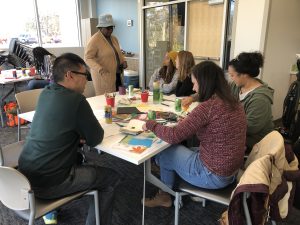20 Activity 5.2 – Toxic Heritage Storytelling Workshop
Laura Holzman

Targeted Skills:
Communication, Creativity,
Format:
A facilitated group activity for audiences ten years and older.
- The workshop can take place in a variety of settings. The activity works best when people can be seated with a flat surface to work on, there is a place to lay out shared materials, and the space is quiet enough for participants to hear the facilitator and each other. The arrangement of tables and chairs is flexible with the main necessity of participants being able to work with a partner and to access shared resources.
- For display of final products, access to a bulletin or magnet board is good, but string and clips can be used to create a display or tables can be arranged in a circle and participants invited to display their work on the tables and walk around to view what each other has created.
- Time: 50 minutes or more.
Toxic Heritage Storytelling Workshop
Materials:
- a selection of pencils, markers, colored pencils, gel pens, crayons, erasers
- scissors
- glue sticks and/or tape
- plain and colored paper
- magazines and other sources to cut up for collages.
- bulletin or magnet board to hang finished work on,
- if there is not a bulletin or magnet board, consider string that could be suspended and clips to attach the work OR arranging tables in a circle and laying the works on them as a display.
- If planning to photograph work, have camera and lighting as needed.
Handouts (optional):
-
- Agenda / activity plan.
- Take action resources (information about local organizations doing environmental or environmental justice work)
- If organizers are collecting the finished work, provide a metadata/cataloging info sheet for creators to provide additional information about their work (see sample metadata).
Step 1: Brief welcome, introductions, goals, and preview of the workshop agenda (c. 5 min)
- Welcome to ….
- Workshop goals
- Develop and share stories of your personal experiences with environmental damage/advocacy for justice
- Build your storytelling skills
Step 2: Warm up – When has a story moved you to take action? (c. 5 min.)
- Action is a change in behavior: taking a stand, trying something new, stopping something you’d done before.
- Invite participants to consider (to themselves)
- When has a story moved you to take action?[1]
- What was it about that story that was so motivating?
- If you haven’t experienced such a story, what do you think might be motivating to you?
Step 3: Activity (30+ min.)
Part 1: Gathering thoughts and ideas – The facilitator leads participants through a thought exercise to tap into their stories. [8-10 minutes]
- Think of a place in [insert your city’s name] that has been significant to your experience of environmental harm or environmental advocacy.
- Close your eyes and picture it. How does it look, sound, smell, taste, feel?
- What do you want people to know about that place?
- Make some notes
- What is your experience with environmental harm or environmental advocacy in this place?
- Make some notes
- Through this experience, what changed…
- About the place?
- About you?
- About others?
- Make some notes
- What other changes related to this experience would you like to see?
- Make some notes
Part 2: Create your story! [15 minutes or more]
- Invite participants to use the materials provided to tell their stories.
- Participants write, draw, cut, collage, make a map, create!
Part 3: Share your story [10 minutes or more depending on size of groups]
- Share your work with a partner or in a small group!
- What do you learn from each other’s stories?
Part 4 (optional): Document the work (if part of a collective project such as exhibit, archive, etc.)
- If you’d like your story to be potentially included in our collective project (exhibit, archive, etc.):
- Fill out an info sheet that we’ll distribute (see sample metadata form)
- Write your name on your story (or put anonymous if you prefer to stay anonymous)
- If you want to take the story with you and still want it available for the collective project, bring your work to the designated area to be photographed.
Part 5 (optional): Share all the stories in a pop-up exhibit!
- Invite participants to post their stories around the room to make a gallery.
- Participants explore the gallery to learn about other individuals’ stories
Step 4. Reflection and call to action (c. 10 min)
- Invite participants to share observations from shared stories and/or their exploration of the gallery.
- Example: what did you see that was especially compelling?
- Facilitator can also notes connections across contributions and/or participants’ observations.
- End with a call to action:
- Thank you!
- Share your story… with us and others
- Learn more about your local community’s toxic heritage – handout or QR code to online resources
- Get involved if you aren’t already
- Provide a handout with local organizations
- This question is inspired by Jessica Gaitán Johannesson's contribution to “Reimagining Climate Resilience Through Ecopolitics,” panel discussion, 31 May 2023, c. 1:10:00. https://media.ed.ac.uk/media/t/1_yjkciz1t. ↵

